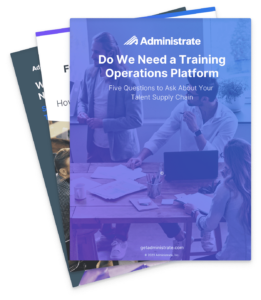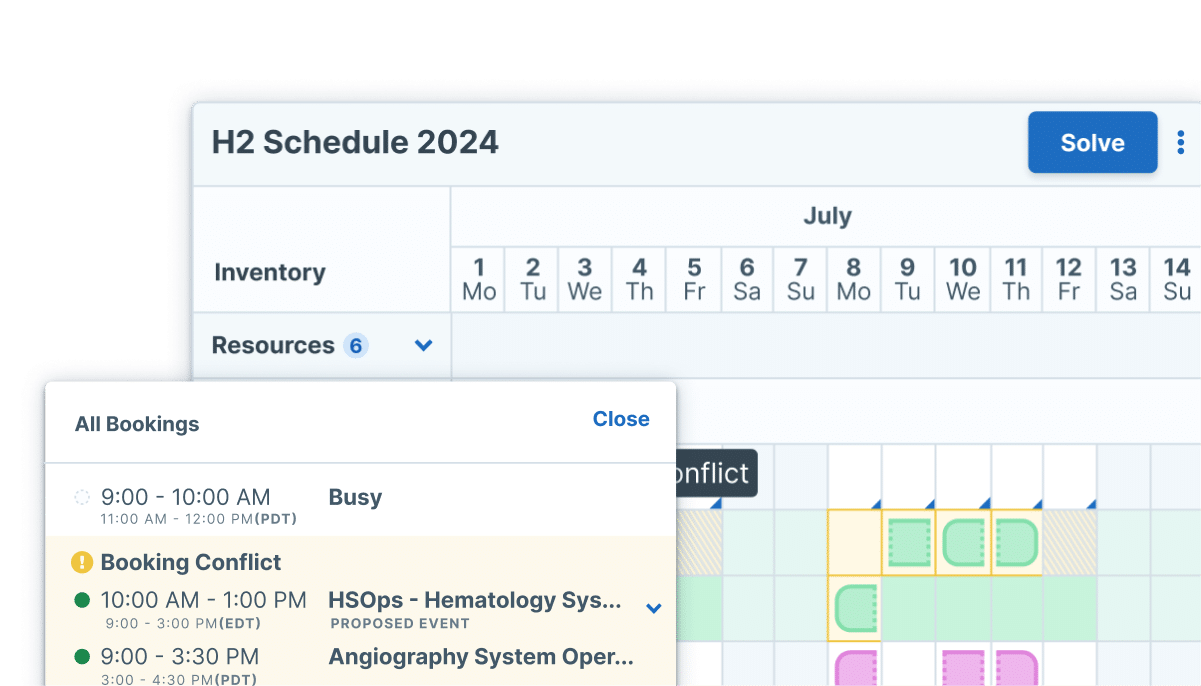Headless architecture is an efficient path to digital transformation.
Most of your training investment is in self paced learning. You likely have more than one LMS, an LXP, and various content management systems representing some big investments (both time and money). But it is likely your most important training happens in a classroom. This isn’t digital transformation. This is a disconnected stack of point solutions struggling to show real ROI but doing a great job at creating more manual work for your team.
This is not your fault. It is not the technology’s fault either. The status quo has lead us here, but this guide will help you understand how to achieve true digital transformation in enterprise training.
Let’s get right to it: digital transformation means adopting a headless architecture. This isn’t just a type of technology, it is an entire philosophy around building and buying enterprise software.
Headless architecture can connect all of these point solutions together into something greater than the sum of its parts. With the right strategy, headless frameworks can help training teams deliver better training at higher volumes without increasing budget and show value on these tech investments.
Why training needs digital transformation
Learning technology is ready for a headless solution.

Training technology is ready for digital transformation. But, wait—we already went digital. Years ago, right? Implementing vILT, blended learning, and self-paced online learning is not a true digital transformation, but more like digital evolution. What training technology needs today is a rebellion against the status quo.
Learning technology evolution or revolution?
Revolution is more than rebellion—although a bit of that is needed in the training industry. Revolution also means resetting the center.
Where is your center when it comes to your learning technology stack? What does your learning tech strategy revolve around? The limited capabilities of a collection of point solutions? Or, are your organization, mission, and business needs at the center of your learning technology stack design?
If you’re still adapting to learning technology rather than building a tech stack that serves the full scope of your program, this guide is for you. We’ll cut to the chase: the answer you’re seeking is a headless architecture approach to learning technology.
From spare parts to a change-driving engine
Learning and development is buried under a mountain of single solution tools and software. While these disparate parts may deliver individual points of value, each tool performs in a vacuum. Reports come standard with each, but are limited to reflecting activity within the tool instead of applying that action to business KPIs. Doing any kind of data analysis usually involves a series of spreadsheets and hours of manual effort.
The problem isn’t so much the front end experience of the tools—it’s the back end management and ROI reporting that’s near impossible for training teams.
Front end tools can’t fix back end problems
The challenge for our training teams isn’t so much the front end experience of the tools—it’s the back end management and ROI reporting that proves impossible. Training leaders running enterprise training programs that offer a wide array of valued learning experiences can begin to feel like they’re staring at a box of parts rather than in possession of a powerful technology engine to drive learning results. Sound familiar?
Learning and development technologies have lacked an open, comprehensive approach. This means training teams are forced to configure their technology suite around unique business needs and strategic plans.
But that time has passed.
Headless architecture enables you to build an engine at the center of your training program. Let’s walk through why, when, and how to bring a headless architecture approach to your enterprise training program—and imagine together what you’ll be able to do with your new-found tech stack liberation.
The revolution is on and your business is at the center. Let’s go.
What is headless technology?
How headless software unleashes enterprise training.

Headless solutions aren’t new. In fact they have been around for a very long time. They are tested and vetted, and many large organizations invest millions into headless technology. But this type of platform has not been available for enterprise training until recently.
Headless technology for scaled growth
Headless systems, long relied upon by other high change, high volume aspects of the enterprise, have arrived for learning technology. Netflix, Amazon, and other world-changing ecommerce giants have utilized headless frameworks for years. Why? This game-changing approach provides organizations with the extensibility to create a holistic technology solution designed to flex and advance with the business.
Adopting this approach makes training change-ready. This guide will explore the benefits of headless architecture specifically for training teams.
“Maersk Training utilizes a headless architecture because it allows us to bring innovations to the market quicker than our competition.“
What is headless architecture for training?
Headless architecture allows your business needs and goals to hold the center of your strategy instead of constantly adapting to the limitations of single-value software. Fundamentally, “headless” means that no single front end tool is going to serve as the head or framework for your entire learning tech stack. Instead, you’ll create and provide that framework—inclusive of your leading front end experience tool, but not limited by it.
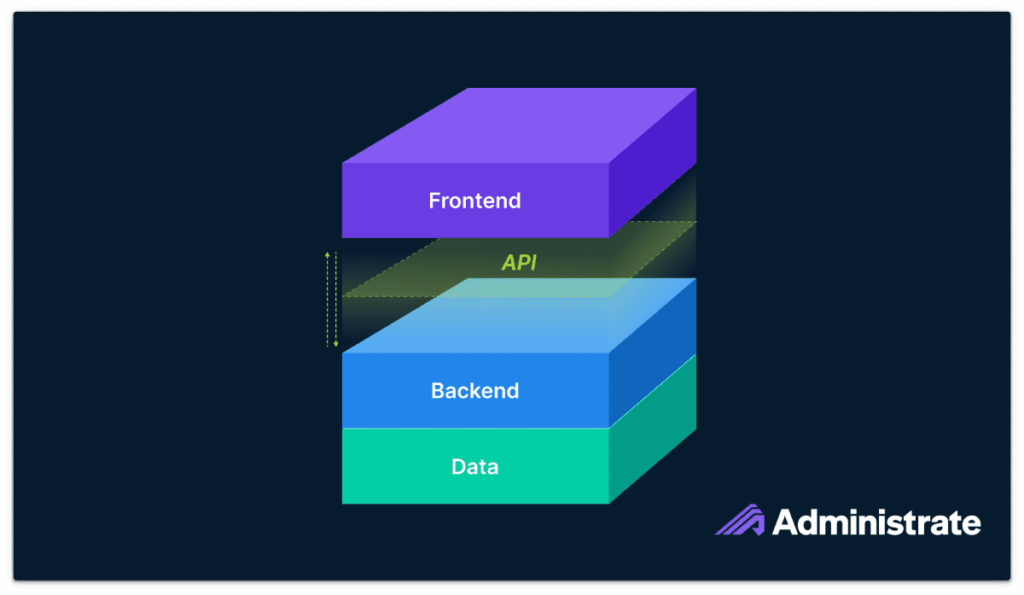
How headless architecture works
- Choose your front end learner experience platforms. Legacy software? No problem. LXP? Sure. Gamification, virtual reality, simulators? Sure. Bring them all.
- Configure the back end business logic to align with your organizational KPIs, requirements, and reporting needs.
- Let the API facilitate automations and data sharing between your custom front end and the back end training management platform.
Why headless architecture works
Six benefits for enterprise training.

A headless approach to learning technology directly responds to some of the biggest challenges being faced by enterprise training teams today. Here are some of the leading benefits of a headless architecture.
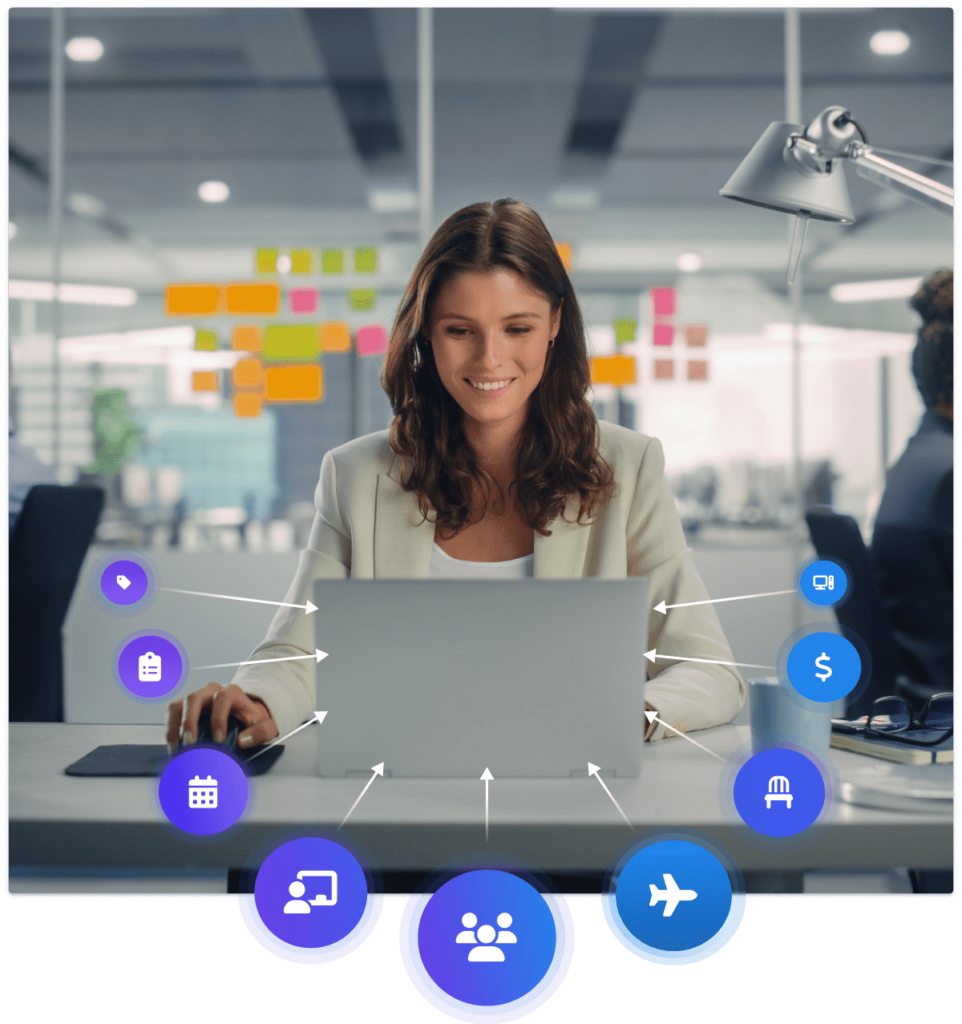
Stop looking for “the answer” and start building your solution.
Six benefits of a headless architecture approach to training
Headless architecture allows a training team to dramatically transform training management, learning experience, and training analytics and reporting. Here are the major benefits of adopting a headless technology to manage training operations.
- Flexible optimization of the learner experience. One solution really does not fit all. The reality is that enterprise training must be able to be customized to the specific needs of the business and the diverse set of roles and learners it has. That’s going to require a variety of learning tools. Enterprise learning tech stacks must be constructed for this level of specialization or the investment is destined to be short-lived. Stop looking for “the answer” and start building your solution.
- Change readiness for competitive advantage. Organizations know now, more than ever, that training is a strategic investment. Whether reskilling for workforce shortages, upskilling for competitive value, or improving employee retention for cost and chaos savings internally, training has the potential to deliver bottom line ROI to the organization. Choosing a learning technology approach that is built to scale rapidly and pivot efficiency can reveal training as a driver of competitive advantage.
- Seamless data integration across the organization. Being able to add and subtract core system integrations to internal systems and data sources is vital to gaining the full ROI from your training activities and the data it produces. A headless approach means that you control this, from within.
- Significant reduction of investment in repetitive, manual work. When you unify training operations through a sole interface, your team will be spending less time doing manual work. Automation of repeating tasks, centralized data for course content and catalogs, centralized resource planning and scheduling are all supported through the back end training management system, seamlessly controlled through APIs.
- Durability of your learning technology investment. Headless technology affords you the ability to change individual point solutions in and out without breaking down the overall management and automation of your training program. Your data architecture is conserved while you gain the opportunity to include emerging technologies and new tool sets. This means change is efficient and time to value speeds up, both major cost saving measures for learning technology.
- Demonstrate training ROI. Accessible data opens the path for more data-driven decision making.
Simply adding on the next software, platform, or tool is not enough. It’s time for learning technology to revolve around you—serving your program, team, and learners while creating operational efficiency and empowering data-driven business decisions. It’s time for a learning tech revolution.
Achieving a transformed learner experience
Headless architecture examples.

So what does a headless approach to training get you? These examples are lifted from real-world scenarios where training teams have implemented headless frameworks to transform learning and development.
Initiate learning anytime, anywhere
Imagine this: you are a busy software engineer that is working to get a specialized certification in a new technology. You have a consistently packed schedule, but today you have 15 mins returned to you when a meeting is canceled. You open a self paced microlearning course on your phone, complete the course in 3 minutes, then move on to something else. You never logged in, you never entered a student portal, you never waited on a sign on server to figure out your credentials. Later when you do log in to training, you see your 3 minute course is logged and part of your profile.
In this example, course performance information is stored in your browser, anonymously, and when you log into their learner portal later, the back end operations layer grabs that data and applies it to your profile. The front end, entirely decoupled from the back end, can store and transmit data on a completely different schedule. Now training can happen anywhere, anytime, and a login isn’t even required.
“Ping Identity would not have been able to deliver anonymous training without the flexibility afforded by a headless training platform like Administrate.”
Deploy multi-channel, just-in-time training
Front end learner experiences are not just limited to online training. Imagine an employee’s safety certification to operate a piece of lab equipment has expired.
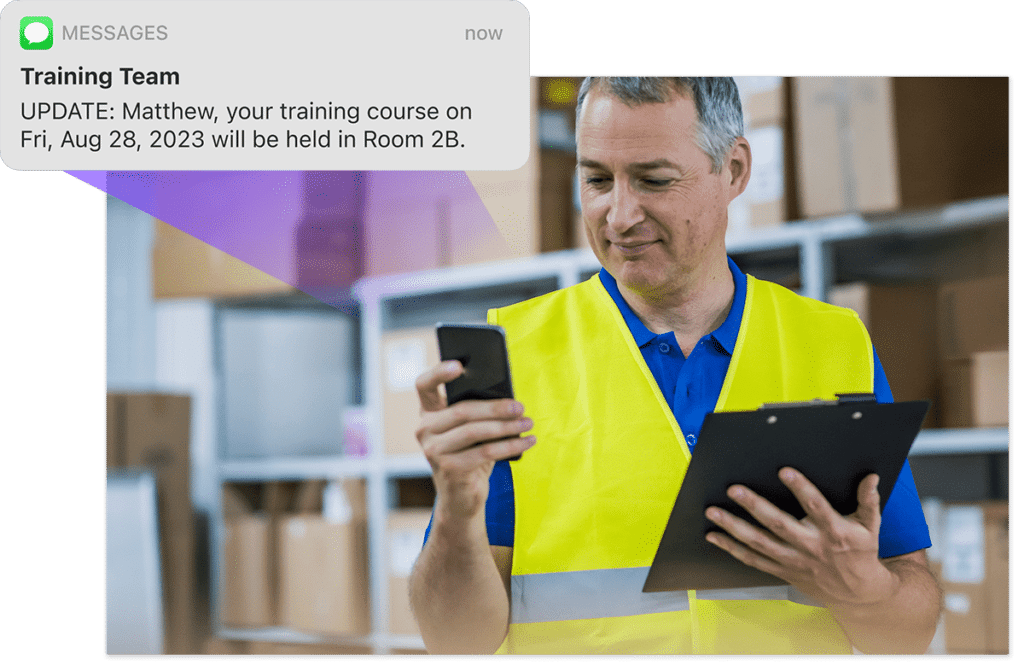
They log in to use the equipment, and are prompted to recertify, being locked out of the equipment until they do. They access training directly on their mobile device, the learner portal serving up the required safety courses. They can finish the course, get their digital certification, and the lab equipment is made available all without leaving the lab.
This sophisticated example is possible when a training management system is decoupled from front end experience, in this case splitting the front experience across devices, delivering a multi-channel learning experience.
Decentralized training, centralized data
Global organizations face unique training challenges, from meeting diverse local requirements and learner preferences to tailored training to facilitate certain skills. Imagine a medical device manufacturer that needs to train health care providers in Canada, Germany, and China.
Typically, each location would have its own unique learner portal with training tailored to meet that location’s regulatory requirements. Training data can become siloed, lost, or difficult to analyze. With headless technology, these localized portals remain unique but training data is consolidated into a centralized platform, and global insights can be leveraged by the training team.
Automate security with credentialing
A nuclear research lab has strict protocols about who can enter certain areas of the facility. Access is directly tied to security clearances, which are on tight expiration dates and also dependent on strict background checks. When a key card is scanned at a door, that data is routed to the decoupled back end operations layer. The key card is quickly identified with a learner profile, the profile is checked for valid security clearance. If there is a problem, the back end layer can send a notification to the key card’s owner reminding them to get their credentials updated.
Implementing headless architecture
A thoughtful, gradual approach is best when implementing a headless approach. Remember, you’re setting a framework to support all of your learning and development experiences and operations. The success criteria for a headless architecture implementation should not be different from any other learning technology deployment, but you can anticipate seeing a significant elevation in training ROI as the approach comes online. Quick time to value can be escalated by leveraging out of the box components and experiences for certain tools, easily integrated through a flexible and secure API.
From point solutions to headless architecture
Explore when to deploy headless architecture in training.

Implementing a headless approach is a true paradigm shift for a training team, and a critical investment for any CLO. There is a lot at stake and multiple deliverables, and many teams simply aren’t ready to adapt this type of technology. Here’s how to test your maturity for headless architecture.
When to implement headless architecture: 3 questions to ask
The decision to implement a headless architecture is not a small one. You’ll want to carefully consider your needs, budget, timeline, and desired value. Here are some key questions to consider.

- What are your significant business goals in the next 12-18 months? Depending on the complexity of your program and its data architecture, you could realize phase one implementation in as little as 12 weeks. Getting a headless architecture in place now can help you realize those goals faster.
- Is your organization large enough to realize value on this investment? The value of implementing a headless architecture is found in simplifying highly complex and diverse training operations typically found in large scale enterprises. Consider if your training program is complex enough to realize this value to scale.
- Do you have the IT resources to manage a headless platform? Connecting front end applications and aligning business logic factors may require developer support. Do you have adequate IT support for the ongoing management of this kind of solution? If you’re not sure, reach out to Administrate’s training management team for a complimentary consultation on finding the right solution for you.
The one decision you need to make now
Headless architecture isn’t a feature. A platform is either built with a headless philosophy or it isn’t. If rapid scale and change—readiness are important to your business and relevant for the next two to three years, now is the time for you to seek a solution with headless capabilities. You’re closing a very large strategic door if you select a vendor that doesn’t support a headless approach.
Is there risk in declining the headless approach? Yes.
Choosing to remain in a learning tech environment defined by disparate front end solutions is an opportunity limiting decision. Not adopting a headless architecture incurs a steep opportunity cost for your training program. Know what is at risk if you determine not to gain headless architecture capabilities.
The risks of not choosing a headless architecture include:
- You won’t have flexibility. Eventually, your training program will need configurability and customized solutions for your learner experience. Without a headless architecture, implementing those one-off solutions will exponentially complicate and multiply manual effort and further bifurcate your data from your organizational objectives. Scaling your program will be painful and expensive, requiring more resources to deliver results.
- You’re set up for obsolescence. The core elements of your learning tech stack will become outmoded. When their value expires and it is time to onboard a new platform, without a headless framework underneath you, you’re destined to rebuild your entire program data architecture to meet the imposed architecture of your new tool. With significant platform changes expected every five years, having a strategy to combat obsolescence is both an operational and financial must.
- You’ll have to work hard to scale and it will go slowly. Without a headless architecture holding space for your training program priorities and alignment with larger business objectives, scaling up becomes a much larger and longer process. Alignment is bound to be difficult, if possible, just as it has been for training until going headless became an option.
If your training team is considering accelerating digital transformation, a headless architecture will be the infrastructure you need. Administrate is a powerful training management system that is built from the ground up as headless architecture. Our largest enterprise clients use our technology to power training operations on the back end, while building custom learner experiences on the front end.
Administrate is the headless architecture solution for enterprise training. Administrate is the only training management software designed with a fully headless approach. Connect front end experiences to our powerful back end operations engine. Speak with an Administrate expert to see how we can help your enterprise.
Your digital transformation starts now






